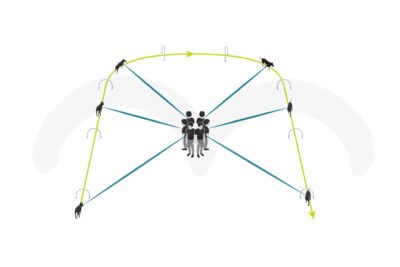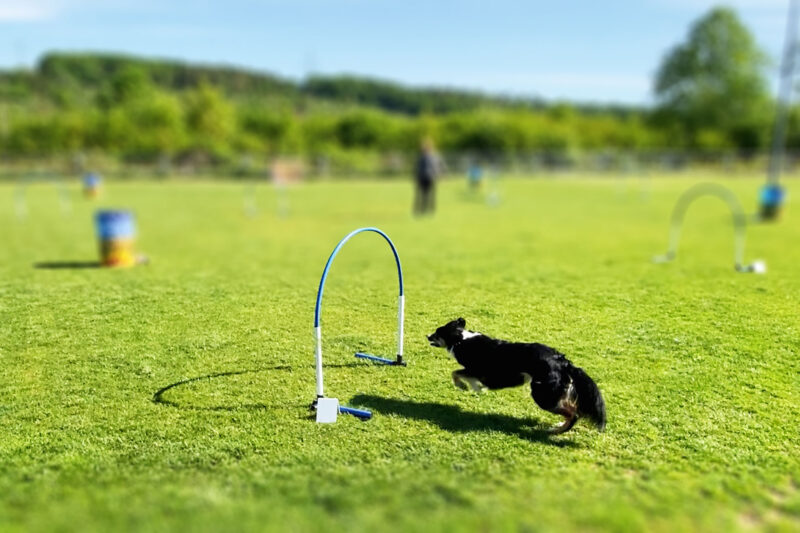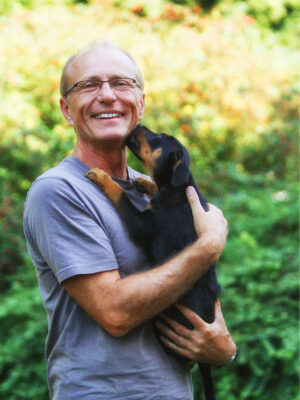›Easy on distance‹
With the effective and easy to understand guidance and communication system ‘easy on distance’, man and dog learn to reach maximum guiding distances with minimal body language. As a holistic guidance system, ‘easy on distance’ makes the smoothest possible mutual exchange of information with the dog possible.
- Achieve maximum distances with minimal body language
- Guide your dog more calmly and concentrate more easily on your signal timing and the course of the course
- Even with physical limitations you can experience this dog sport together with your dog
- Your dog has to decode less signals and concentrates better on his running line
- Your dog perceives relevant signals better
- He works much more independently – without having to focus on you all the time and waiting for your help.
- By working independently your dog becomes more self-confident
- Even restless, highly excited or insecure dogs become calmer and work more concentrated.
When guiding at a distance, not only does the guardian send usable signals, but the dog as well. The guardian learns to observe the dog, to read his body signals and to classify them correctly to be able to help him if necessary. This ability is another important component of leading at a distance that should not be underestimated.
Already during the set-up of the directional signals, the dog learns to carry out a certain movement sequence only by means of an auditory signal. In the subsequent distance training on the individual obstacles, the dog learns to “detach” himself from the human: Using a reduced form of body language in conjunction with the learned auditory signal – without visual signals from the arms – the dog learns to approach the corresponding obstacle at a long distance.
The reduced body language limits overshadowing of the auditory signals. The dog runs more independently, does not have to look at the guardian all the time and can concentrate better on the auditory signals and the obstacles in the course. Especially when he moves out of the guardian’s field of vision or is guided at a large distance, he cannot clearly perceive visual signals.
The guardian also benefits from the calm way of guiding. He can concentrate better on the course and the necessary signal timing. He has a better focus on the dog and can react more specifically to the dog’s signals to be able to help him if necessary.
The “guiding-beam” forms the basis of ‘easy on distance’ visually and the “keep-going-signal” acoustically. In combination with directional signals and targeted micro-impulses, it is possible to guide at a distance without overtaxing the guardian or the dog.
Key points of communication with ›easy on distance‹
The guiding beam
 The so-called guiding beam is a body language oriented communication link between man and dog. With its help, the dog is guided through the course and kept on the optimal running line. This calm way of body language communication reduces possible mistakes of the human during distance work. In addition, the dog focuses less on the human and works more independently overall.
The so-called guiding beam is a body language oriented communication link between man and dog. With its help, the dog is guided through the course and kept on the optimal running line. This calm way of body language communication reduces possible mistakes of the human during distance work. In addition, the dog focuses less on the human and works more independently overall.
The lead signal
The lead signal is an acoustic signal such as ‘RUN, RUN’, which we use in distance work as a ‘keep going’ signal for longer lasting behavior. Properly set up, it becomes a bridge signal and tells the dog that he is on the right track. He should continue to show the behavior until the marker signal is given, which announces the reward.
The micro-pulse
The micro-pulse is an optically or acoustically oriented auxiliary impulse that helps the dog to avoid mistakes even at long distances in order to maintain the desired optimal running line. Dogs also communicate with each other via micro-pulses and are therefore very receptive to this minimalist form of communication.
Communication between man and dog
Safe and unambiguous communication between man and dog is crucial for success in this sport. Between humans, language is the most important means of communication. However, in addition to the spoken word, facial expressions and body posture play an essential role in conveying information correctly and successfully. The sender and receiver must be able to encode and decode the message unambiguously so that the information can be successfully understood and processed.

Communication with the dog works according to the same principle: sender: signal – receiver: decoding. The human sends a signal to the dog, the dog perceives it, has to process and ‘decode’ it and finally implement it.
For successful guiding at a distance, the right timing, i.e. the right moment of signaling, is very important – especially for signals to change direction. The duration from the signaling to its implementation is the dog’s reaction time. For example, at a speed of four meters per second, the dog continues to run about four meters from the time the signal is given until it is implemented. The timing is therefore always dependent on the individual running speed and reaction time of the dog.
The right body language
The correct body language when guiding at a distance is always that which the dog can understand. Too many or uncoordinated signals from the human in the form of extreme hand and body movements cannot be understood by the dog. Too many visual signals also overshadow auditory signals. To decipher these uncoordinated signals, the dog ends up trying to read the human’s entire expression of visual and auditory signals – but cannot filter which of the many signals are relevant at the moment. As a result, he reacts insecurely and makes unnecessary mistakes. A clear and reduced body language makes it easier for the dog to process and implement the signals.
The use of auditory signals
The same applies to communication by means of auditory signals: as much as necessary, as little as possible. Too many different auditory signals in a short time can be difficult for the dog to decipher at the appropriate running speed and on a demanding course.
In addition, the human must also be able to call up and announce the right auditory signal at the right moment. Fewer and clear auditory signals make it easier for both the human to give the signal and the dog to process and implement it.
The right guiding system
In the meantime, there are many different approaches in Hoopers and thus also different guidance systems: Some use a lot of body language, others use a lot of auditory signals to guide. Which guidance system works best for your own human-dog team is something everyone has to decide for themselves based on experience.
With ‘easy on distance’ we rely on a reduced body language and as few as possible, clearly defined guiding elements to achieve maximum guiding distances.
Michael Kroner
Michael is a certified dog trainer and behavior consultant IHK-BHV. He lives with his wife Elke and three Working Kelpies in beautiful Baden-Württemberg.
His dog school “Alphateam” is a practice company of the BHV and supports in this context the further education as a dog trainer and behavior consultant IHK/BHV. Also his knowledge and experience from agility and herding training with his own dogs, flow into the further development of the dog sport Hoopers.

As one of the first, he has made Hoopers known in Germany and developed it further. Since 2012, he has been doing Hoopers with his dogs and teaches this dog sport. Through the numerous seminars he offers nationally and internationally since the beginning of 2014, he knows the needs of the participants. As a result, since 2018 he has also been successfully offering advanced trainer training courses for prospective Hoopers trainers from clubs and dog schools.
In addition, Michael was involved in the development of the VDH’s testing regulations and judges’ guide.
The collected experiences and the acquired knowledge about this dog sport, he would like to share with other Hoopers enthusiasts.
The development of Hoopers
The North American Dog Agility Council (NADAC) developed a variant of the popular dog sport agility, in which additional bows (hoops) were integrated into the classic course.
Inspired by this, dog trainer and non-fiction author Tanja Bauer developed the dog sport now known in Europe as ‘Hoopers’ in 2011. As in classic agility, the dog is supposed to run through a course in a certain order. This contains however no hurdles to jump over, but consists mainly of Hoops, which the dog runs through – supplemented by tunnels, barrels and gates.
As substantial difference to all earlier variants Tanja farmer integrated the guidance at distance: Without running along, one leads the dog from a fixed guidance range at large distance by the Parcours. The dog is led through the course with audible and visual signals. Changes of direction must be announced or indicated in good time in order to set the optimum running line.
Hoopers quickly inspired more and more dog sportsmen. Regulations were created and judges were trained.
Since 2020 Hoopers has been recognized as a dog sport in the VDH, the German Canine Association. On the basis of the developed examination regulations, official competitions are now possible.
Hoopers is a running sport and in the course the dog can reach high speeds, which is why corresponding stresses are to be expected here as well. Therefore, this sport should also only be practiced with healthy dogs – and care should be taken during training not to overtax the dog.